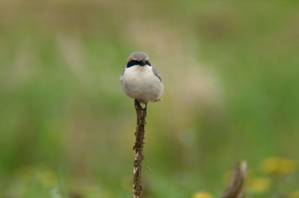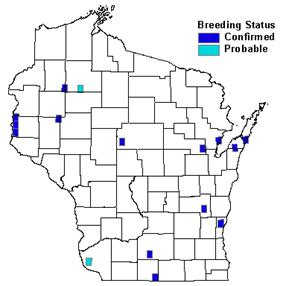Photo by Ryan Brady


Status/Protection
- Global Rank: G4 Key to global and state ranks
- State Rank: S1B
- WBCI Priority: SCGN, State Endangered
Population Information
The Federal BBS information can be obtained at http://www.mbr-pwrc.usgs.gov/bbs/bbs.html by clicking on Trend Estimates and selecting the species in question. All estimates are for time period (1966-2005).
*Note: There are important deficiencies with these data. These results may be compromised by small sample size, low relative abundance on survey route, imprecise trends, and/or missing data. Caution should be used when evaluating this trend.
- Federal Breeding Bird Survey: significant decline
- Federal Breeding Bird Survey (WI): N/A
- Federal Breeding Bird Survey (BCR 23): non-significant decline*
- Federal Breeding Bird Survey (BCR 12): N/A
- WSO Checklist Project: stable (1983-2007)
Life History
- Breeding Range: Central Prairie Provinces of Canada south to Gulf states and southern Mexico (Yosef 1996).
- Breeding Habitat: Grassland-shrub, grass/ag types with appropriate shrub nesting areas.
- Nest: cup-shaped twig nest lined with soft material, located 4-8 feet from the ground in a shrub or small tree.
- Nesting Dates: March-June.
- Foraging: Feeds on insects and small vertebrates; hunts from a perch and kills vertebrate prey by attacking the back of the neck; prey are impaled on sharp object for storage and feeding.
- Migrant Status: Short-distance migrant.
- Habitat use during Migration: no information, probably similar to breeding habitat.
- Arrival Dates: early April – mid-May.
- Departure Dates: Sept. – mid-October.
- Winter Range: Southern half of U.S. and Mexico.
- Winter Habitat: similar to breeding habitat including hayfields and idle pasture.
Habitat Selection
Loggerhead Shrikes prefer short to medium height grasslands including pastures, dry old fields, Grassland-shrub, dry-mesic prairie, oak savannah, and orchards. Shrubs and/or low trees (usually thorny) are required for nesting, perching, and impaling prey (Sample and Mossman 1997). Nests are often found in hawthorn, red cedar or plum trees 4-8 feet off ground (Robbins 1991, Yosef 1996). Loggerhead Shrikes are also found in mowed roadsides, cemeteries, golf courses, riparian areas, open woodlands with nests near isolated trees or large shrubs (Yosef 1996) and residential areas in proximity to idle grasslands. Nesting shrikes can be quite tolerant of nearby human activity.
Habitat Availability
Idle grassland, Grassland-shrub, dry sand to mesic prairie, and oak savannah are uncommon and vulnerable to succession to forest or conversion to row crops or housing developments. Pastures and dry old fields are common but also vulnerable to conversion. Not all grasslands and prairies contain the needed nesting structure, further limiting habitat availability. However, in some locations, there are what appear to be large areas of suitable habitat that are not being used. Orchards are uncommon but appear stable (Sample and Mossman 1997). The Loggerhead Shrike’s territoriality also limits the number of birds that can inhabit a certain area (Yosef 1996).
Population Concerns
The southern 2/3 of Wisconsin is part of the northern limit of the Loggerhead Shrike breeding range, which migrates further south in winter (Robbins 1991). This species is endangered in Wisconsin and the “northern” shrike populations have undergone serious declines in the latter half of the twentieth century (Yosef 1996, Robbins 1991). Loggerhead Shrikes have been nearly extirpated in Wisconsin with less than 5 nesting reports discovered on an annual basis. While the reasons for this decline are not clear, habitat loss and changes in farming practices on both breeding and wintering grounds is the speculated cause (Knutson et al 2001). Yosef (1996) lists a number of studies indicating that shrikes preferred grassland landscapes with high percentages of pasture. It’s possible that as Wisconsin’s dairy industry has moved to rowcrop/feedlot practices, that it has impacted Loggerhead Shrikes. However; large pastures still remain in central and southern Wisconsin. Weather, increased use of pesticides and predation reducing nest production and changes in wintering habitat (Brooks and Temple 1990) may also be contributing to the problem (Yosef 1996). It’s not clear what is limiting populations in Wisconsin and it’s unlikely that local efforts can effectively reverse these factors.
Recommended Management
Grassland management practices such as burning, mowing, and grazing that still leave a few scattered shrubs or trees present for nesting will provide suitable habitat for Loggerhead Shrikes. These same practices should also maintain their prey base (Sample and Mossman 1997). Other management recommendations include keeping cattle out of shelterbelts, maintaining brush along fence lines and hedgerows and keeping scattered trees in pastures and fields. Reproduction rates of Loggerhead Shrikes are high and there is enough unocccupied habitat that a population rebound is possible if the factors responsible for the shrike’s decline can be identified and eliminated (Yosef 1996).
Research Needs
Cause(s) of population decline needs to be determined through nesting and habitat use studies to aid in establishing proper management practices (Yosef 1996). It’s unclear if such studies can actually be performed in Wisconsin or whether they’d need to be done further south at the core of the northern range limit. Since this species is endangered in Wisconsin, accurate and timely reports on nesting locations would help agencies in species management.
Information Sources
- David Sample, Grassland Community Ecologist, Wisconsin DNR Research Center, 1350 Femrite Dr., Monona, WI 53716.
- North American Breeding Bird Survey: http://www.npwrc.usgs.gov
- Temple S. A., J. R. Cary, and R. Rolley. 1997. Wisconsin Birds; A Seasonal and Geographical Guide. Wisconsin Society of Ornithology and Wisconsin Department of Natural Resources, Madison, WI.
- NatureServe Explorer: http://www.natureserve.org/explorer/index.htm
- Wisconsin Breeding Bird Atlas: http://www.uwgb.edu/birds/wbba/
References
- B. L. Brooks, S. A. Temple 1990b . Dynamics of a Loggerhead Shrike population in Minnesota. Wilson Bull. 102: 441–450.
- Knutson, M. G., G. Butcher, J. Fitzgerald, and J. Shieldcastle. 2001. Partners in Flight Bird Conservation Plan for The Upper Great Lakes Plain (Physiographic Area 16). USGS Upper Midwest Environmental Sciences Center in cooperation with Partners in Flight. La Crosse, WI.
- Robbins, S. D., Jr. 1991. Wisconsin Birdlife: Population and distribution past and present. Madison, WI: Univ. Wisconsin Press.
- Sample, D. and M. Mossman. 1997. Managing Habitat for Grassland Birds: A Guide for Wisconsin. Wisconsin Department of Natural Resources: Madison, WI.
- Yosef, R. 1996. Loggerhead Shrike (Lanius ludovicianus). In the Birds of North America, No. 231 (A. Poole and F. Gill eds.). The Academy of Natural Sciences, Philadelphia and The American Ornithologists’ Union, Washington, D.C.
Contact Info
- Compiler: Jenny Herrmann, mherrmann4@wi.rr.com
- Editor: Kris Belling, WDNR; kristin.belling@dnr.state.wi.us
